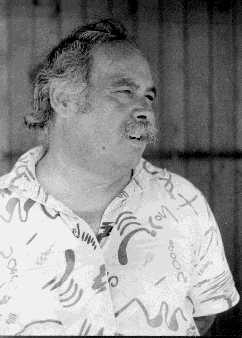Stass Paraskos

Stass Paraskos (Greek: Στασίνος Παράσχος; born 1933) is an artist from Cyprus, although much of his life was spent teaching and working in England.
Early life
Paraskos was born in Anaphotia, a village near the city of Larnaca, Cyprus in 1933, the son of a shepherd farmer. He went to England in 1953 and became a cook in his brother's restaurant in the city of Leeds. This was a popular haunt of the local art students who encouraged Paraskos to enrol for classes at Leeds College of Art (later Leeds Metropolitan University). Despite not having the usual entry qualifications, Paraskos was spotted by the college's inspirational Head of Fine Art, Harry Thubron, who made certain Paraskos was accepted. There he became close friends with artists such as Dennis Creffield, Terry Frost and Wilhelmina Barns-Graham, with Frost and Barns-Graham persuading Paraskos to move to St Ives in Cornwall in 1959. In St Ives Paraskos shared a studio with Barns-Graham until he returned to Leeds in 1961 and began teaching at Leeds College of Art.[1]
Obscenity case
In 1966 Paraskos was involved in a notorious court case in which it was alleged he displayed paintings that were 'lewd and obscene', in contravention of the Vagrancy Act 1838. The court case was one of a number of important legal challenges to the freedom of the arts in the 1960s and 70s, starting with the Lady Chatterley trial in 1960, and ending with the Oz magazine trial in 1971. Despite luminaries of the art world speaking in Paraskos's defence, including Sir Herbert Read and Norbert Lynton, and messages of support from Britain's Home Secretary Roy Jenkins, Paraskos lost the trial and was fined five pounds.[2] Out of this Paraskos was invited in 1967 to take part in a group exhibition, Fantasy and Figuration, alongside Pat Douthwaite, Herbert Kitchen and Ian Dury at the Institute of Contemporary Arts in London.[3] Dury was later to become a close friend as they both began teaching at Canterbury College of Art in 1970.[4]
Teaching career
Paraskos started teaching part-time at Leeds College of Art in the early 1960s after returning from St Ives in Cornwall. He also taught at Leicester Polytechnic before becoming a Lecturer in Fine Art at Canterbury College of Art. When Canterbury College of Art became Kent Institute of Art & Design, he was appointed a Senior Lecturer in Fine Art and then Head of Painting, before returning to Cyprus to run the Cyprus College of Art.[5]
Style and influences
Paraskos's style of painting is figurative but non-naturalistic, and he uses bright colours to describe scenes which often seem rooted in his childhood in Cyprus. He is also influenced by the Byzantine church art of Cyprus, and modern masters, such as Paul Gauguin and Henri Matisse. Despite primarily being a painter, in 1992 he began work on an ambitious sculpture wall, in the village of Lempa, on the west coast of Cyprus. This wall is made of found and recycled everyday objects, and comprises a mixture of abstract and figurative forms, including a King Kong-sized gorilla, a pigmy elephant and a giant pair of welcoming hands. The wall is twenty metres long and up to four metres high.[6]
In his book Aphrodite : The Mythology of Cyprus the late George Thomas, 1st Viscount Tonypandy, a frequent traveller to Cyprus commented: "...Greek mythology provides an eternal fascination... Stass Paraskos, one of Cyprus' most distinguished artists provides in this book an exciting recital of the influence Greek mythology has brought to bear on Greek Cypriot development..."[7]
Artistic career
Paraskos has exhibited in places including in Cyprus, Britain, Greece, the United States, Brazil, India, Denmark, and in 2003 was the subject of a book by the distinguished art historian Norbert Lynton, published by the Orage Press. His work is represented in the State Collections of Cyprus, the National Gallery of Greece, the Collection of the Arts Council of England, Leeds University Art Collection, Leeds City Art Gallery and the Tate Gallery (Tate Britain), London. In 2008 he was awarded an Honorary Doctorate by the University of Bolton for his services to art and art education.[8]
See also
- Michael Paraskos, his son
References
- ↑ Norbert Lynton, Stass Paraskos (Mitcham: Orage Press, 2003) 7f
- ↑ Benedict Read (ed.), Herbert Read: A British Vision of World Art (London: Lund Humphries, 1993) 18
- ↑ ICA, Fantasy and Figuration, exhibition cat., London, 1967, Tate Archive (London) ref. LON-INS (S.C.)
- ↑ Richard Balls, Sex and Drugs and Rock and Roll (London: Omnibus Press, 2001) p79 and passim.
- ↑ David Haste, Stass at Canterbury, in Michael Paraskos (ed), Stass Paraskos (Mitcham: Orage Press, 2009) 36f
- ↑ John Cornall, Stass and Cypriotness, in Michael Paraskos (ed), Stass Paraskos (Mitcham: Orage Press, 2009) 16f
- ↑ Preface to Stass Paraskos, Aphrodite: The Mythology of Cyprus (London: Interworld, 2000) 1f
- ↑ Evi Papadopoulous (ed), The Kean World of Orange (Limassol: Kean Ltd, 2009) 42
External links
|